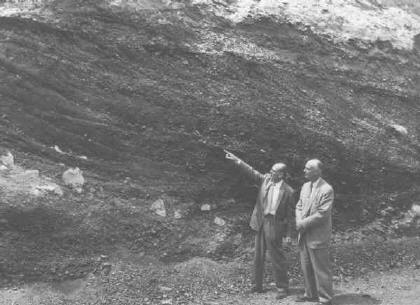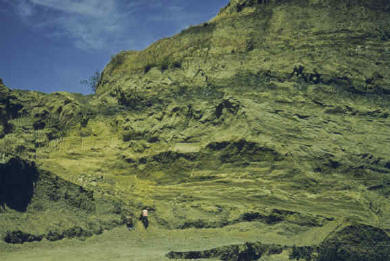|
The
Pink Granite Problem
A few of the water worn Miocene shells have been found in the sediments
of the lower hills. This means that some of the Irvington sediments were
produced by erosion of the older Mission Peak strata. But the source of the
other Irvington rocks rounded pebbles and cobbles of pink and granite, for
example has not been determined. That is, no primary source for these rocks is
known in the San Francisco Bay area.
 |
| Wes Gordon pointing out cross-bedding
structures at Bell Quarry |
There are exposed granite about 60 miles south-southeast of Irvington
that could have provided the pink pebbles. The material could have been carried
the 60-mile distance and deposited at Irvington by waters flowing north. There
is strong evidence to support this possibility: First, Irvington deposits are
cross-bedded. “Crossbedded” means that small structures within the
sedimentary layers are inclined at various angels. The angles are measured from
the horizontal line. The angels help determine the direction of flow of the
waters which deposited the sediments. If sediments are deposited by
northwesterly-flowing waters, they exhibit cross-bedding inclined toward the
northwest. This is the condition at Irvington. As stated earlier, Irvington
sedimentary beds dip 20 degree to 25 degrees northeast because of faulting, This
dipping took place after the cross-bedding had been established.
There, is, however, another possible source for the pink granite pebbles,
as well as for other varieties of Irvington rocks. They could have come from old
conglomerates (consolidated gravels) that lie along the base of an extension of
Mission Peak about 12 miles south-southeast. The argument against this
possibility is that most of the rocks in the fossil-bearing Irvington hills are
much too rounded and polished to have been carried such a short distance. An
explanation for the physical condition of the rocks one that could support the
12 mile hypothesis is that they were shaped before they became part of the bed
of conglomerate. (The geologists would say these rocks might have been shaped
during a “previous cycle of erosion.”) More accurately, the rolling trip for
12 miles to final deposition at Irvington would have merely added to their
roundness and polish, rather than having been wholly responsible for it.
 |
|
View of sediments in the Bell Quarry.
Irvington fault on South Creek back of T2 1961 |
Compared with the Miocene deposits of Mission Peak and the Pleistocene
deposits at Irvington, the pebbles that compose the conglomerates are indeed
ancient. They were deposited about 130 million years ago. But many of the
pebbles and cobbles at Irvington the chert and quartzites, for example are
thought to be even older. This means that they probably were shaped during a
much earlier cycle of erosion. The extreme hardness of these particular rocks
probably enabled them to survive many cycles of burial and reburial.
Obviously, fossils cannot be the only concern of a paleontologist (or
pale ecologist). The reconstruction of an ancient ecosystem requires knowledge
of physical as well as of biological factors. Knowing the source of rocks in a
bed of sediment containing fossils can lead to knowledge about where the ancient
streams aids in reconstructing the extinct landscapes, and reconstructing the
landscapes helps to determine the environment of plants and animals that lived
at that time.
How would you proceed to develop methods for solving the problem of the
pink granites?
|